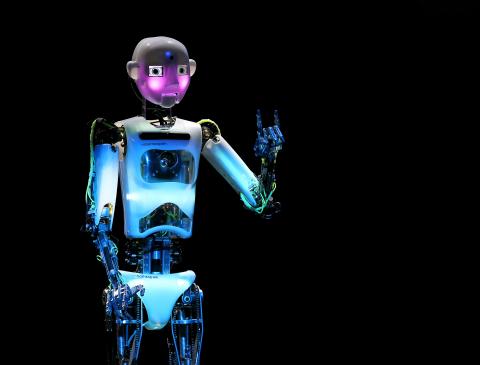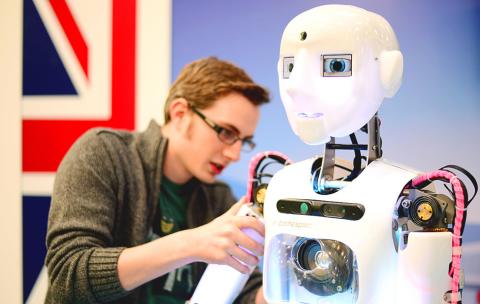You don’t have to be paranoid to think there are eyes following you around the Cornwall warehouse that is home to Engineered Arts.
Indeed, if you were not being watched, there would be something wrong, as those eyes belong to robots made by the British company that has become an industry leader by creating humanoid, commercially available robots that can hold eye contact with you, perform Singin’ in the Rain and guess your age — all at the same time.
Engineers are now working on making them walk, hop and jump.

Photo: Reuters
Just inside the front door of the Penryn factory is a line of RoboThespians, human-sized rigid robots whose arms move while the little screens that represent their eyes follow the person in front while telling jokes in one of 30 languages.
Up to 20 of the machines, priced at between £50,000 and £55,000 (NT$2.49 million and NT$2.73 million), are sold every year to museums, universities and companies to communicate and entertain at exhibitions, trade shows and events. The Kennedy Space Center in Florida and Israel’s National Museum of Science, Technology & Space are among the institutions that have them.
“It was ‘make an automated presenter,’” said Will Jackson, founder of Engineered Arts. “That was the mission. It was to make something that could stand in a spot all day, every day, and tell the people things but do it in an entertaining way and use gestures.”

Photo: EPA
NEVER GETS NERVOUS
With a background in special effects, Jackson was working on exhibitions for central London’s Science Museum in the 1990s when he came on the need for a machine that could explain concepts and ideas to people repetitively in an entertaining fashion and not be nervous when talking to a group of people.
“It is really tedious for someone to stand in a space and repeat the same information all day every day,” he said. “It was ripe for automation.”
The RoboThespian’s movements can be controlled by a tablet. The robot can guess the mood and age of people (although years frequently appear to be shaved off) and blow kisses in the air before breaking into song. It is, said Jackson, the first full-sized humanoid commercially available robot — orders can usually be ready to ship within two weeks.
“It is making machines that can have the properties of people. This is key for making a performing robot. It has huge industrial applications as well because if you can make a machine which is safe around people and it is able to behave like a person, you can then do collaborative tasks, you can start solving all kinds of other problems,” he said.
The next stage of development will see the creation of Byrun, a 30kg machine about 170cm tall that will be able to walk, hop and jump. A working prototype is expected in a year, said Jackson, with five of his 14 employees focusing on creating a “strong, lightweight, but bouncy and compliant” robot.
Under the plans for the androgynous Byrun, the robot’s fingers will be sensitive to pressure and temperature. The proportions and locations of the joints are designed to make it as close to the human form as possible. Jackson expects it to cost between £350,000 and £400,000 (NT$17.40 million and NT$19.88 million) when it comes to market and hopes to sell about 10 a year for research and development.
FUTURE OF ROBOTICS
Nine years after setting up the company, which Jackson and his wife own, he said his “life goal” was making a machine that performed like a person. However, his creations would never be sold to any military body, he said.
“Ethically, I am opposed to the mechanization of death and I don’t want to get involved with anything that makes it easier to kill people from a distance, so as a company we are fundamentally opposed to any use of robots for military purposes. We get asked now and again [to sell] but we just don’t do it,” he said.
As the quality and uses for commercially available robots continue to develop, debate has increased as to what their role will be in society in the coming decades. The US think tank the Pew Research Center recently surveyed some 1,900 technology experts and found them split over what the future holds, but almost half reckoned both blue and white-collar workers would be significantly displaced in their jobs by robots or artificial intelligence by 2025.
Jackson, however, thinks we are up to 20 years away from being able to produce humanoid robots that could be cheap utility devices capable of manipulating objects.
“I don’t believe in this classic idea of robots as servants to humanity, certainly not humanoid-shaped ones. We do have robots that do a lot of utility tasks — in your home you probably have a dishwasher, you have a washing machine. Those are the robots that you are going to see around your home. You are not going to see something with two legs, not unless it is a toy. Those things are fun but they are practically useless for doing utility tasks,” he said.
“If you look at industrial robots where a lot of the humanoid technology has come from, they are designed for very, very precise position control: ‘get object from A to B, get it there within a tenth of a millimeter.’ That is not how we operate, we operate in a very tactile sort of way. When you are leaning on the table, you don’t know that the table is 802.3mm high, you just know that you put your elbows there.”
In the UK, Iain Gray, chief executive of the Technology Strategy Board (an advisory body to the ministry for business), recently highlighted OC Robotics, which designs and manufactures “snake-arm” robots for confined spaces, and MapleBird, which develops tiny unmanned aerial vehicles, as British companies also making prominent steps in the robotics industry.

June 2 to June 8 Taiwan’s woodcutters believe that if they see even one speck of red in their cooked rice, no matter how small, an accident is going to happen. Peng Chin-tian (彭錦田) swears that this has proven to be true at every stop during his decades-long career in the logging industry. Along with mining, timber harvesting was once considered the most dangerous profession in Taiwan. Not only were mishaps common during all stages of processing, it was difficult to transport the injured to get medical treatment. Many died during the arduous journey. Peng recounts some of his accidents in

“Why does Taiwan identity decline?”a group of researchers lead by University of Nevada political scientist Austin Wang (王宏恩) asked in a recent paper. After all, it is not difficult to explain the rise in Taiwanese identity after the early 1990s. But no model predicted its decline during the 2016-2018 period, they say. After testing various alternative explanations, Wang et al argue that the fall-off in Taiwanese identity during that period is related to voter hedging based on the performance of the Democratic Progressive Party (DPP). Since the DPP is perceived as the guardian of Taiwan identity, when it performs well,

A short walk beneath the dense Amazon canopy, the forest abruptly opens up. Fallen logs are rotting, the trees grow sparser and the temperature rises in places sunlight hits the ground. This is what 24 years of severe drought looks like in the world’s largest rainforest. But this patch of degraded forest, about the size of a soccer field, is a scientific experiment. Launched in 2000 by Brazilian and British scientists, Esecaflor — short for “Forest Drought Study Project” in Portuguese — set out to simulate a future in which the changing climate could deplete the Amazon of rainfall. It is

Artifacts found at archeological sites in France and Spain along the Bay of Biscay shoreline show that humans have been crafting tools from whale bones since more than 20,000 years ago, illustrating anew the resourcefulness of prehistoric people. The tools, primarily hunting implements such as projectile points, were fashioned from the bones of at least five species of large whales, the researchers said. Bones from sperm whales were the most abundant, followed by fin whales, gray whales, right or bowhead whales — two species indistinguishable with the analytical method used in the study — and blue whales. With seafaring capabilities by humans